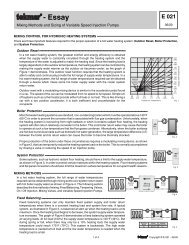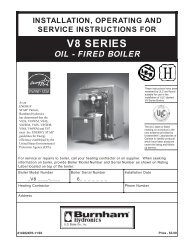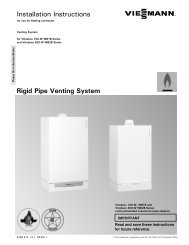Radiator Venting and living with Steam Hogs.pdf - Heating Help
Radiator Venting and living with Steam Hogs.pdf - Heating Help
Radiator Venting and living with Steam Hogs.pdf - Heating Help
You also want an ePaper? Increase the reach of your titles
YUMPU automatically turns print PDFs into web optimized ePapers that Google loves.
<strong>Radiator</strong> <strong>Venting</strong> <strong>and</strong> Living <strong>with</strong> <strong>Steam</strong> <strong>Hogs</strong>There is a lot of good information written on venting radiators. Here are some links that maybe of help to you.http://www.heatinghelp.com/article/328/One-Pipe-<strong>Steam</strong>-Systems/138/Balancing-One-Pipe-<strong>Steam</strong>-SystemsI would highly suggest you get Gerry Gill <strong>and</strong> Steve Pajek’s venting book.http://www.heatinghelp.com/products/<strong>Steam</strong>-<strong>Heating</strong>-Books/25/146/Balancing-<strong>Steam</strong>-Systems-Using-a-Vent-Capacity-Chart-by-Gerry-Gill-<strong>and</strong>-Steve-PajekI refer to this book all the time. The venting tables in this book are also included in “Greening <strong>Steam</strong>”http://www.heatinghelp.com/products/<strong>Steam</strong>-<strong>Heating</strong>-Books/25/158/Greening-<strong>Steam</strong>-br-How-to-Bring-19th-Century-<strong>Heating</strong>-Systems-into-the-21st-Century-i-<strong>and</strong>-save-lots-of-green-II would also recommend you go to Gerry Gill’s website. Gerry Gill is a very experienced Clevel<strong>and</strong> steam pro <strong>and</strong> hasposted a lot of info on his website about steam heating <strong>and</strong> venting. http://www.gwgillplumbing<strong>and</strong>heating.com/What I’m going to talk about below is a phenomenon that I ran across the first time I changed my radiator vents. I hadjust greatly increased the venting capacity of the main vents on the steam mains <strong>and</strong> was very pleased <strong>with</strong> theincreased performance of the system. My next thought was, “Well, since it worked so good on the mains, increasing theventing capacity on the radiators should be equally productive!” So I installed the largest capacity radiator ventsavailable on all of the radiators in the house. The outcome was a disaster! Some rooms whose radiators were closest tothe boiler overheated <strong>and</strong> radiators in other rooms didn’t heat at all! This was my first introduction to what I call“<strong>Steam</strong> Hogging” <strong>and</strong> it proved that the Deadman’s old adage ‘Vent your mains quickly <strong>and</strong> your radiators slowly “ iscorrect!Perhaps before we talk about “hogging” we should mention a few things about what happens when steam condenses.When steam “collapses” (condenses), it instantly reduces in volume close to 1600 times.When this happens it leaves a huge vacuum void where the steam used to be. If the collapsing steam issurrounded by condensate (water) , the surrounding water rushes in to fill the void <strong>and</strong> when it collides <strong>with</strong> the waterrushing in from the other side of the void we get the sound which we call “water hammer”. If the collapsing steam issurrounded by steam, then the surrounding steam rushes in to fill the void. This leads to an increased pressuredifferential which, if it occurs inside a radiator, draws in more steam. If it is a large radiator <strong>and</strong> has a large capacityradiator vent, steam is able to quickly fill the radiator. If the radiator is cold this will lead to very rapid condensing <strong>with</strong>the resulting production of large volumes of condensate (water) <strong>and</strong> a high volume of heat. The large volume ofcondensate can cause problems as it will interfere <strong>with</strong> the incoming steam The vacuum resulting from the highcondensing, pulls in more <strong>and</strong> more steam <strong>and</strong> leads to the “hogging”condition. I’ve put together a diagram which may
help explain this condition..In the above drawing. The “trough” represents the steam main which is fed by the boiler through the feed pipe in theforeground. The large hogs close to the boiler end of the trough represent the large radiators typically found in <strong>living</strong>rooms <strong>and</strong> dining rooms.* “Hogging” occurs when the large “hogs”, <strong>with</strong> their uncontrolled condensing, gobble up allthe available steam before it reaches the other “hogs” down the trough (main). If the thermostat controlling the boiler isin a room <strong>with</strong> one of the large hogs, the heat the large hog is giving off may cause the thermostat to turn off the burnerbefore the hogs further down the main get any steam. The end result is the hogs (radiators) close to the boiler overheat<strong>and</strong> the hogs (radiators) farther away from the boiler remain cool.*In the case of apartments, the large hogs represent those apartments on the steam main closest to the boiler.
The solution is to ration the steam to the large hogs near the boiler so that all hogs receive their fair share of steam.Since you can’t throttle the inlet of the radiator on a 1 pipe steam system <strong>with</strong>out causing problems between theincoming steam <strong>and</strong> the outgoing condensate, the best way to control the initial intake of steam is to slow down the ratewhich air is escaping the radiator which slows the speed/volume of steam entering the radiator.I use adjustable radiator valves (Vent-Rites) on most of my radiators <strong>and</strong> to have further adjustable control of the outputin bedrooms <strong>and</strong> to shut down sections of the house in winter, I use TRVs.You mentioned your system now has very high capacity vents on the radiators <strong>and</strong> there are problems <strong>with</strong> some unitsoverheating <strong>and</strong> other units that stay cold so I would suspect that your system has some sort of “hogging” condition. Iwould suggest you get the venting on the steam mains straightened out first <strong>and</strong> then change the venting on the radiatorsto slower vents. To better underst<strong>and</strong> this process of sizing radiator vents I would again refer you to the books Imentioned at the beginning of this write up. After you have the steam mains <strong>and</strong> radiator venting straightened out ifyou then find you need more venting on long radiator laterals I would then possibly consider “master venting” on theproblem laterals.- Rod















